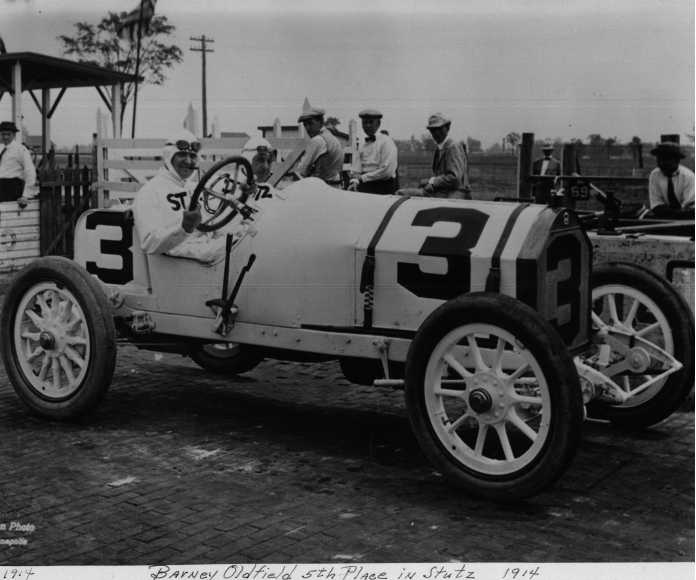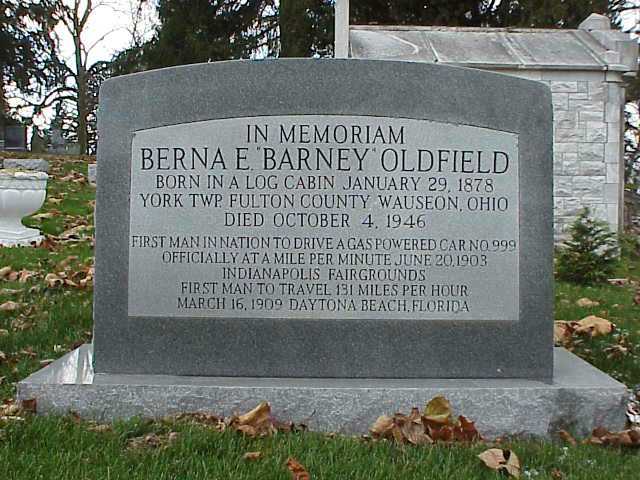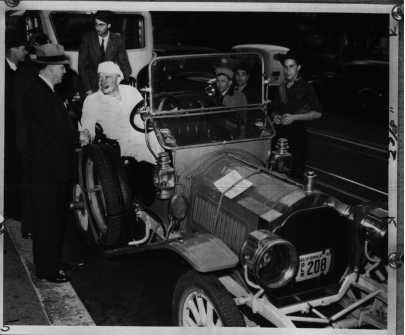Barney Oldfield was born in a farmhouse on the outskirts of Wauseon, Ohio. In 1889, when he was 11 years old, he moved with his family to Toledo. By 1904, Oldfield was America's most famous race car driver, owning the most track wins and virtually all the world's track speed records. Until 1913, during the peak of his career and popularity, Oldfield called Toledo home.
Oldfield's place in racing history and American popular culture was not due simply to his success in competition. Indeed, if this was the only measure of his success, his achievements would be viewed as mixed. Oldfield never won the greatest races of his day - the Gordon-Bennett Cup, the Vanderbilt Trophy, or the Indianapolis 500. No other driver of his day spent as many years banned from official competitions for violation of the American Automobile Club's rules. Judged only by his certified victories, Oldfield's record does not match up with such contemporaries as Bob Burman or Ralph DePalma.
Rather, Barney Oldfield's fame and significance were achieved as a result of his being a pioneer and, more importantly, as being the man most responsible for introducing Americans to auto racing and for preventing it from becoming a gentleman's sport in the same league with Polo and Yachting. Oldfield was a pioneer, not only as a racer, but as a working class racer.
When Oldfield began racing in 1902, racing was solidly an elite sport. Most drivers were millionaires and competitions were organized by automobile clubs that were exclusive, not only by reason of their selective membership policies, but by the simple fact that in those days automobiles were handmade and priced beyond the reach of all but the wealthiest. Those few drivers who came from more humble backgrounds, like DePalma, ingratiated themselves to the elite by wearing the livery of a servant.
DePalma, for example, maintained a strict dress code with his crew - pressed and bleached whites from head to toe at all times. As in horse racing, the owner of the car was credited with victories along with the driver, and sometimes the driver received even less attention! Oldfield's working class credentials were solid: born in a log cabin on a marginal farm, his father a laborer and his mother a seamstress, pressed into work as a newsboy before his teenage years, following his father into railroad labor, kitchen service, and finally bell boy and elevator operator in Toledo's downtown hotels. The family home in Toledo was a small, wood frame house on the outskirts of town, near enough to the mainline railroad tracks that the neighborhood would shudder when the express went through and far enough from the core of the city that outhouses stood in all the backyards. His first experience with speed was hitching a ride on the fire trucks, whose runs in a city bursting at the seams were all too frequent. His second was on a bicycle he stole at night from the hotel storage room where he worked. After his brief and limited success as a professional bicycle racer (he placed second in the state championship), his goal in life was to become a prizefighter or a salesman. He didn't succeed at either.
Auto racing found Oldfield as much as Oldfield found it. When his old bike teammate, Tom Cooper, needed help maintaining the racing car that he had purchased from Henry Ford, he called up his old friend Barney. Cooper quickly discovered why Ford was willing to let go of the powerful racer that he had designed - it seemed impossible to control at track speeds. Overpowered for its size, without springs or shocks of any kind, steered by a tiller that looked better suited to opening manholes, and its length making turning even more of a feat, the "999" required a wrestler more than a driver. Who better to give it try but the failed boxer and bike racer? The beast of "999" had met its match. Oldfield wrenched the car around the turns in a sliding cloud of dust that became his trademark, and discovered his talent at last. When he took "999" out against the favored Winton, driven by the industrialist Winton himself, he nearly lapped his opponent while setting the Grosse Point, Michigan track record. The words "track record" would hang next to Oldfield's racing results with impressive regularity for the next two years.
"Who Do You Think You Are? Barney Oldfield?"
Not surprisingly, the elite racing fraternity that had every intention of keeping auto racing in the country club set frowned on Oldfield's attitude, success, and popularity. When no one could touch Oldfield on a track, where quick, skidding turns were Oldfield's stock in trade, the elite sponsored straightaway races on the Daytona beaches so that they could claim a few laurels of their own. They promoted road rallies where driving skill was less important than the durability of the machine. Finally, they monopolized control of race sanctioning and simply excluded Oldfield from certified competitions for petty infractions of their rules, such as racing in unsanctioned exhibition events at county fairs - activities that Oldfield viewed as making a living.
In 1911, Oldfield was banned from competition on the eve of the much heralded Vanderbilt Cup races. The following year, he was declared "banned for life" from the Indy Brickyard for giving exhibition races against his partner Bob Burman (though Burman was not similarly barred). So furious was the racing establishment’s opposition to Oldfield that when he announced his retirement from competition driving and took a job as a manager of the Firestone racing team, the A.A.A. refused to even allow him to be present at a track where his own team was racing. Oldfield was eventually reinstated, but he remained bitter at his lost opportunities.
 Barney Oldfield in his race car.
Barney Oldfield in his race car.
Oldfield's technical offense was precisely what cemented his lasting fame as a race car driver. Oldfield took racing out of the clubbish confines of sanctioned tracks and brought it to average Americans around the nation. At a time when traveling shows and circuses were the primary entertainment in rural America (and when rural Americans were still the majority of the population), Oldfield took his famous cars with their fantastic names - the Blitzen Benz, the Green Dragon, the Golden Submarine - on the barnstormer circuit and gave the folks a show. For many, Oldfield's cars were not the first they had ever seen, but were the first they had ever seen that were driven by someone they could recognize as one of their own.
At a time when most working class Americans viewed cars as playthings of the rich that frightened horses and children, when one of the dangers of driving outside the city was angrily thrown rocks and farm wagons that tried to shoulder the horseless off the road, when communities passed laws setting low speed limits and prohibitions that were intended to deter automobiling altogether, along came Barney Oldfield, cigar clenched in his teeth, bottle hung around his neck, roaring fearlessly around a small dirt track - subduing his frighteningly loud machine as a cowboy busts a bronco. The millionaires in control of the A.A.A. never understood that Oldfield was the best weapon they had to batter down popular resistance to the growth of their sport, though they benefited from him all the same. No wonder that the Madison Avenue advertising geniuses picked Oldfield to represent their clients, despite the fact that, by the time he was being used to hawk tires in full page ads in the Saturday Evening Post, he hadn't won a race in years. Both Broadway producers and Hollywood directors built productions around him. A man whose name enters the vernacular - Cop to motorist: "Who Do You Think You Are? Barney Oldfield?" - was clearly someone who struck a chord with the common folk.
Oldfield's connection to the town of his birth remains strong. People in Wauseon still remember their most famous son. One of the largest monuments in the town graveyard is a stone commemorating him, though his remains rest in California. In 1988, Wauseon celebrated "Barney Oldfield Days" and the local newspaper occasionally runs a feature about him. The Fulton County Historical Society has preserved a few cherished Oldfield artifacts: one of his barnstorming posters, the handmade crib he slept in, and a genealogy that traces the Oldfield family back to the 18th century.
"But Toledo has largely forgotten him. . ."
But Toledo has forgotten him. The Toledo Blade has not written a major story on Oldfield since 1961. The only biography of him, written by William Nolan – the author of Logan's Run – cannot be found in any library or bookstore in the city. Oldfield is not mentioned in any of the histories of the city and has but one mention in the seventy-year run of the area's academic historical journal, The Northwest Ohio Quarterly. No monument marks his family home which still stands on South Street. No businesses memorialize his contribution to the auto industry that still dominates his hometown. No businesses, bridges, streets, buildings, parks, places, rooms, or even a bench, are named for him. There are only three Oldfields in the phone book.
Here, then, is a small step towards filling the gap. Here is a remembrance and celebration of the achievements of Barney Oldfield, Toledo’s and Wauseon's Speed King.
 Barney Oldfield 5th place in state, 1914
Barney Oldfield 5th place in state, 1914 Oldfield in an advertisement
Oldfield in an advertisement Barney Oldfield's memorial marker
Barney Oldfield's memorial marker
Oldfield's Track Victories
| 10/23/1902 | Grosse Point, MI | Manufacturer’s Cup Challenge | :05:20.0 | 5 | 56.2 | 999 |
| 12/01/1902 | Grosse Point, MI | 1 mi. Dirt Track - Track Record | :01:01.2 | 1 | 59 | 999 |
| 05/30/1903 | Yonkers, NY | Empire City 1 mi. dirt track | :05:31.0 | 5 | 54.2 | 999 |
| 07/18/1903 | Jackson, MS | Jackson 1/2 mile dirt track | :01:16.0 | 1 | 47.5 | 999 |
| 07/25/1903 | Yonkers, NY | Empire City 1 mi dirt track - track record | :55.8 | 1 | 65 | 999 |
| 11/22/1903 | Los Angeles, CA | Los Angeles 1 mi dirt track - track record | :54.6 | 1 | 65.6 | Winton Bullet |
| 10/29/2004 | Yonkers, NY | Empire City 1 mi dirt track - 10 mi standing start record | :09:12.6 | 10 | 64.9 | Peerless Green Dragon II |
| 12/09/2009 | Dallas, TX | Dallas 1 mi dirt track | :47:18.0 | 50 | 63.5 | Benz |
| 04/08/2010 | Los Angeles, CA | Playa del Ray 1 mi Motordrome (inaugural) | :36.22 | 1 | 99 | Benz |
| 08/08/2010 | Philadelphia, PA | Point Breeze 1 mi dirt track (6 hour race) | 261 | 43.5 | Knox | |
| Feb. 1913 | Playa del Ray | Banked Board Track | - | - | Christie | |
| Feb. 22, 1913 | Imperial Valley, Ca. | Imperial Valley Road Race | 4:41:00 | 203 | Fiat | |
| 10/10/2014 | Los Angeles to Phoenix | 7th Cactus Derby, 671 mi. Desert Road Race | 0:01:00 | 671 mi. | 29.1 | Stutz |
| 03/17/1915 | Venice, California | Venice Grand Prix | 0:24:09 | 300 mi. | 68.5 | Maxwell |
| 03/20/2015 | Tucson, Arizona | Tucson Road Race, 2.1 mi course | 0:31:39 | 103 | 67.29 | Maxwell |
| 05/16/2018 | Uniontown, Pennsylvania 1 1/8 mi. Board Speedway | 5 5/8 mi. Match Race | :03:18.51 | 5.625 | 102 | Golden Submarine |
| 07/18/2018 | Uniontown, Pennsylvania 1 1/8 mi. Board Speedway | 5 5/8 mi. Match Race | :03:20.0 | 5.625 | 101 | Golden Submarine |
| 05/21/2027 | Culver City, California 1 1/4 mi. Board Speedway | 1000 mi. Closed Body Stock Car Run | 0:05:00 | 1000 mi. | 76.4 | Hudson |
Barney Oldfield's Speed Trial Wins
| 6/19/1903 | Indiana Fairgrounds 1 mi. dirt track | First circular mile under 60 seconds in US | :59.6 | 1 | 60.4 | 999 |
| 7/04/1903 | Columbus, OH | 5 mi. exhibition | :05:00.6 | 5 | 60 | 999 |
| 1904 World’s Records made in Peerless Green Dragon II | ||||||
| 1 mi :00:51.2 70 mph | ||||||
| 5 mi :04:30.0 66.5 mph | ||||||
| 10 mi :09:12.0 65.0 mph | ||||||
| 15 mi :14:05.0 63.7 mph | ||||||
| 20 mi :18:45.4 64 mph | ||||||
| 25 mi :23:38.6 63.2 mph | ||||||
| 30 mi :28:38.8 62.9 mph | ||||||
| 35 mi :33:36.6 62.2 mph | ||||||
| 40 mi :38:31.6 62.4 mph | ||||||
| 45 mi :43:29.0 62.4 mph | ||||||
| 50 mi :48:39.2 62 mph | ||||||
| 8/19/2009 | Indianapolis, IN | Indianapolis 2 1/2 mi Macadam Motor Speedway (Inaugural) - 1 mi speed trial | :43.0 | 1 | 83.1 | Benz |
| 3/16/2010 | Daytona-Ormond Beach, FL | 1 mi straightaway record | :27.33 | 1 | 131.724 | Blitzen Benz |
| 3/16/2010 | Daytona-Ormond Beach, FL | 5 mi straightaway record | :27.33 | 5 | 128.88 | Blitzen Benz |
| 12-Sep | Cleveland, OH | 2 mi. track | :1:35.8 | 2 | - | Christie |
| 13-Apr | Bakersfield, CA | dirt track | :46.4 | 1 | - | Christie |
| 5/28/2016 | Indianpolis, IN | Brickyard Record - first over 100mph at Indy | :1:27.7 | 2.5 | 102.6 | Christie |
| 8/09/2017 | St. Louis, Missouri, 1 mi. Dirt Track | Non-competitive Speed Records: | ||||
| 1 mi: :00:45.00 80 mph | ||||||
| 2 mi: :01:30.40 79.5 | ||||||
| 3 mi: :02:17.60 78.5 | ||||||
| 4 mi: :03:05.60 77.5 | ||||||
| 5 mi: :03:53.60 77.2 | ||||||
| 10 mi: :07:56.20 75.5 | ||||||
| 15 mi: :12:00.80 75.0 | ||||||
| 20 mi: :15:52.20 75.5 | ||||||
| 25 mi: :19:57.60 75.4 | ||||||
| 25 mi: :19:57.60 75.4 | ||||||
| 50 mi: :40:47.60 73.5 |


